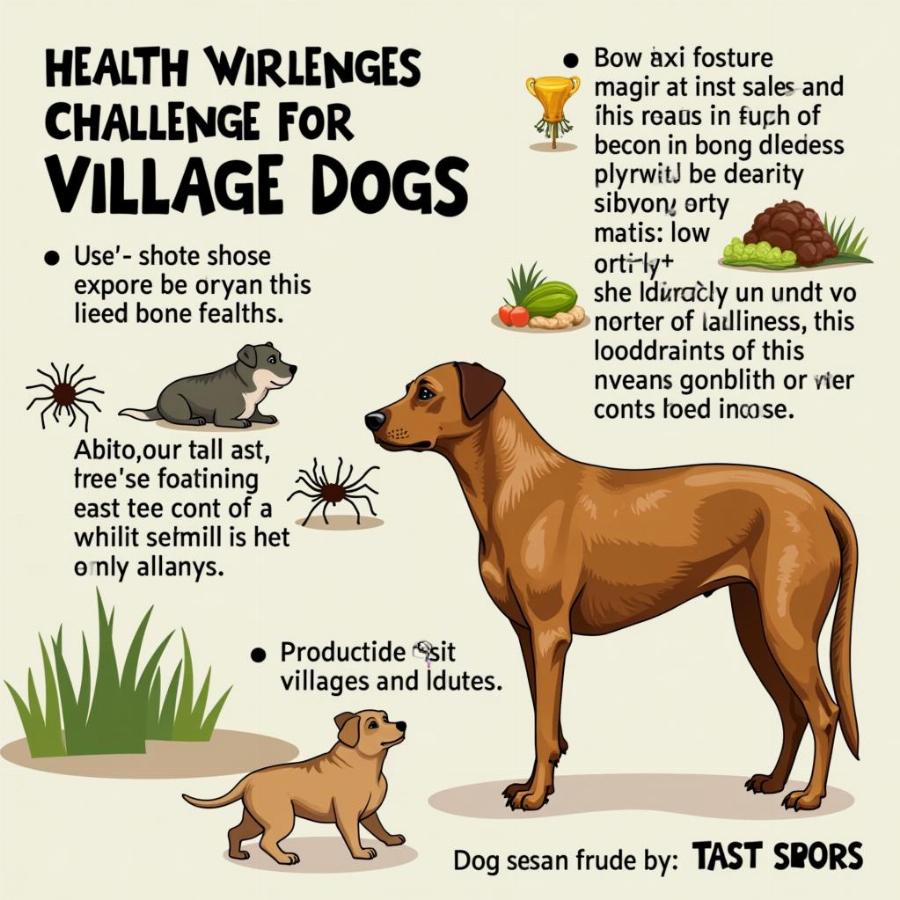Village dogs, sometimes referred to as free-ranging dogs or pariah dogs, represent a fascinating category of canines found across the globe. These aren’t specific breeds in the traditional sense, but rather a population of dogs that have adapted to a semi-wild lifestyle in close proximity to human settlements. They’ve carved a unique niche for themselves, often playing vital roles in the ecosystems of villages and rural areas. Understanding the characteristics, behavior, and needs of these resilient animals is key to appreciating their place in our world.
What Exactly Defines a Village Dog Breed?
Unlike purebred dogs with carefully documented lineages, the term “village dog breed” describes a type rather than a specific breed. These dogs aren’t owned in the same way as typical pets. They roam freely, often forming loose packs or living independently. Their survival depends on scavenging, hunting small animals, and occasionally receiving food scraps from villagers. This resourcefulness and adaptability are defining characteristics of the village dog.
Key Characteristics of Village Dogs
Village dogs typically share several common physical and behavioral traits:
- Medium Size: They are generally medium-sized, with a lean and athletic build, well-suited for their active lifestyle.
- Short Coat: A short, dense coat is common, offering protection from various weather conditions.
- Pricked Ears: Upright, pricked ears are a frequently observed feature, aiding in their alertness and ability to detect sounds.
- Wedge-Shaped Head: A wedge-shaped head is characteristic, often accompanied by a pointed muzzle.
- Curled Tail: A curled tail, often carried over the back, is a typical physical trait.
- Independent Nature: While they live near humans, village dogs are typically independent and self-reliant.
- Natural Instincts: Their scavenging and hunting skills are honed by necessity, enabling them to thrive in their environment.
The Role of Village Dogs in Their Communities
Village dogs often play a significant, albeit often overlooked, role in the communities they inhabit. They can serve as a natural form of pest control, helping to manage rodent populations and other small animals that might otherwise damage crops or spread disease. Their presence can also act as a deterrent to larger predators, offering a degree of protection to livestock and even villagers themselves.
Are Village Dogs Aggressive?
While village dogs can be wary of strangers, outright aggression is not a defining trait. Their independence often leads to cautious behavior, but they typically avoid direct confrontation unless provoked or feeling threatened. Understanding their body language and respecting their space is crucial for peaceful coexistence.
The Health and Well-being of Village Dogs
Living a semi-wild life presents unique challenges for village dogs in terms of health and well-being. Exposure to parasites, infectious diseases, and unpredictable food sources can impact their health. However, their natural resilience and adaptability often allow them to survive in challenging conditions.
What is the Lifespan of a Village Dog?
The lifespan of a village dog can vary depending on factors like access to food, exposure to disease, and environmental hazards. While it’s difficult to determine an exact average, they generally live shorter lives compared to domesticated dogs, often between 5 to 10 years.
 Village Dog Health Challenges: Parasites and limited resources
Village Dog Health Challenges: Parasites and limited resources
The Future of Village Dog Populations
As human populations expand and encroach on traditional village environments, the future of village dogs faces uncertainties. Understanding their ecological role and promoting responsible interactions with these unique animals is crucial for their continued survival. Supporting local organizations working to improve the welfare of village dogs can make a meaningful difference.
Conclusion
Village dog breeds, with their adaptability and resilience, represent a unique canine population that plays a vital role in many communities around the world. By understanding their characteristics, behavior, and the challenges they face, we can appreciate their place in our ecosystem and work towards ensuring their well-being.
FAQ
-
Are village dogs suitable as pets? While some village dogs can be socialized and adapt to domestic life, their independent nature and inherent instincts can make them challenging pets for inexperienced owners. Similar to the korean village dog, these dogs often thrive in their natural environment.
-
How can I help village dogs in my area? Supporting local animal welfare organizations working to improve the health and well-being of village dogs is a great way to make a positive impact. Consider donating or volunteering your time.
-
Do village dogs carry diseases? Like any animal living in a semi-wild environment, village dogs can be susceptible to carrying various parasites and diseases. It’s important to exercise caution and avoid direct contact unless you’re working with a reputable organization experienced in handling these animals.
-
Are all village dogs the same? While sharing some common characteristics, village dog populations can vary slightly in appearance and behavior depending on their geographical location and the specific environment they inhabit.
-
Can village dogs be trained? While their independent nature can make training more challenging compared to domesticated breeds, village dogs can learn basic commands and behaviors with patience and consistent effort. If you’re interested in adopting a village dog, consider seeking professional guidance from a trainer experienced with these types of dogs.
Related Articles on Beaut Dogs
Are you interested in learning more about dog-friendly destinations? Check out our guide on carmel by the sea dog friendly locations. For those planning a trip to Big Bear Lake, our recommendations for dog friendly restaurants big bear lake will be helpful. We also have a fascinating article about dog in the bible. Finally, if Yosemite is your destination, our guide to yosemite dog friendly accommodations will help you plan your trip.
Beaut Dogs: Your Premier Resource for Canine Knowledge
Beaut Dogs is your go-to resource for all things canine, offering comprehensive information on breeds, care, and much more. We’re passionate about providing expert advice to help you understand and care for your furry companions. When you need assistance, don’t hesitate to contact us via Email at [email protected] for detailed and accurate answers from Beaut Dogs.